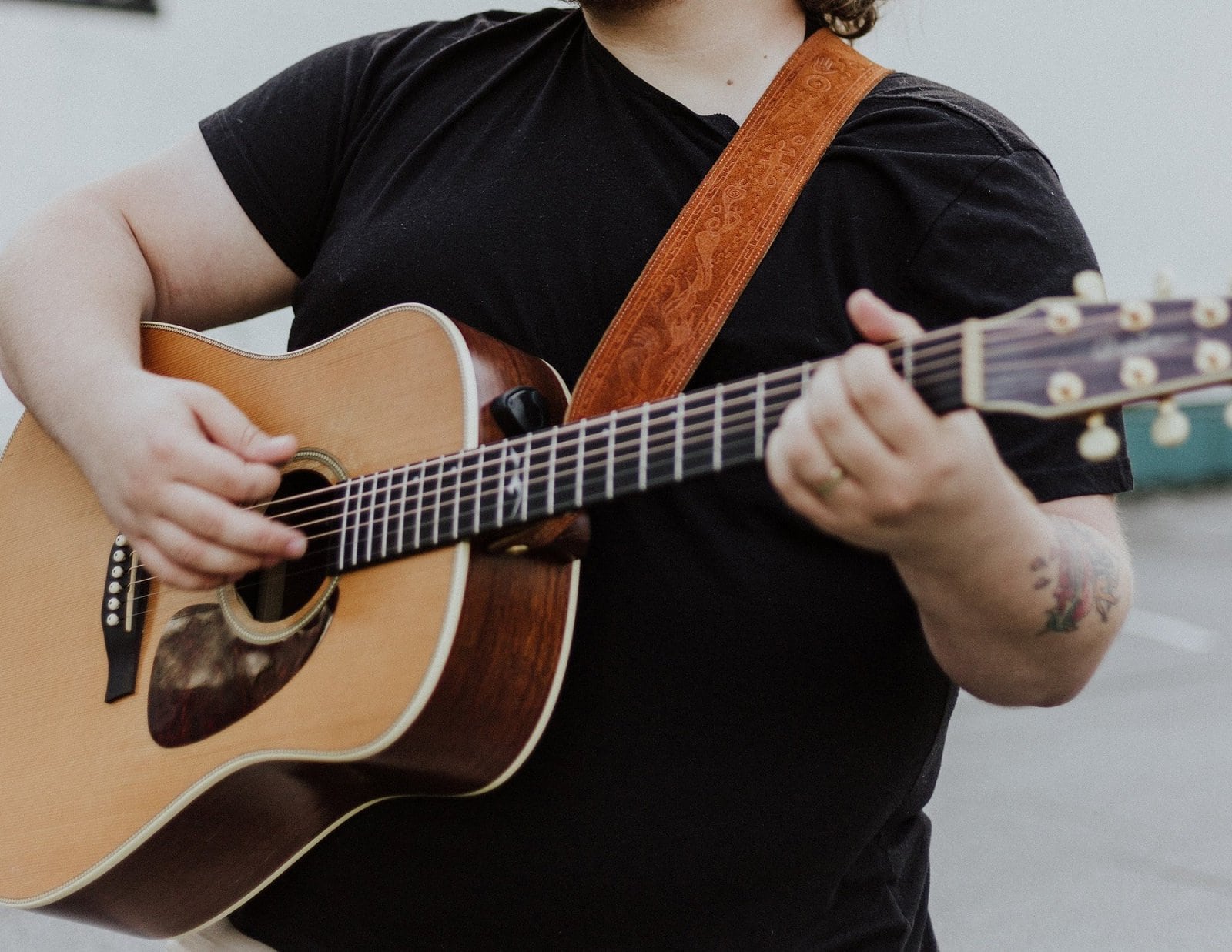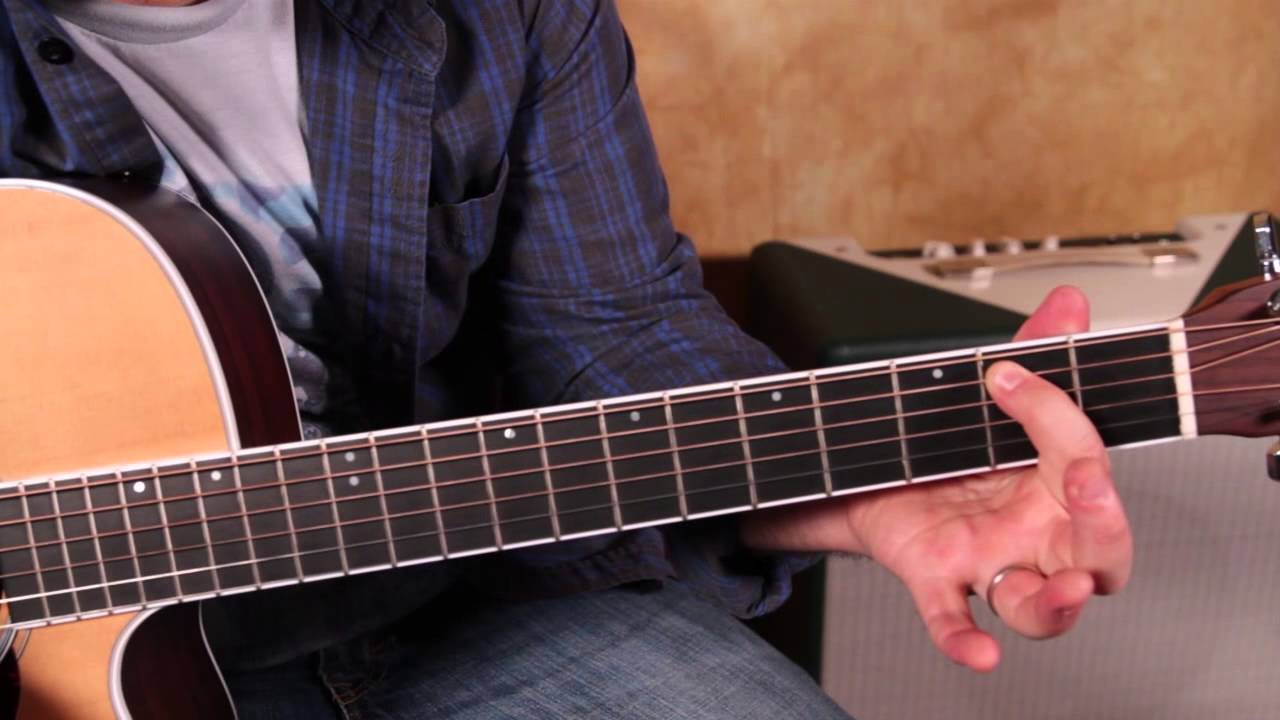Introduction
The acoustic guitar is a versatile and beloved instrument that has the power to captivate audiences with its warm and intimate sound. Whether you are a beginner or an experienced player, finding the right songs to play on the acoustic guitar can enhance your skills and bring joy to your musical journey.
Choosing the right songs for the acoustic guitar is crucial, as different songs require different techniques and styles of playing. From classic ballads to modern hits, there is a wide range of genres and songs that can be beautifully interpreted on the acoustic guitar.
This article will guide you through the process of selecting songs that sound good on the acoustic guitar. We will explore the factors you should consider, such as the style of the guitar, the complexity of the song, and your personal preferences. Additionally, we will showcase some classic and contemporary songs that are well-suited for the acoustic guitar. We will also discuss how to adapt songs to fit the acoustic guitar and provide tips for personalizing your interpretations.
Whether you are playing on your own or performing for others, the acoustic guitar offers a unique and authentic sound that can create a magical atmosphere. By choosing the right songs and adding your personal touch, you can create captivating performances that will resonate with your audience.
Understanding the Acoustic Guitar
The acoustic guitar is a stringed instrument that is widely recognized for its beautiful and natural sound. It is distinguished from its counterpart, the electric guitar, by its hollow body and lack of electronic amplification. This means that the sound produced by an acoustic guitar is purely acoustic, relying on the resonance of the body and the vibration of the strings.
Acoustic guitars come in various shapes and sizes, each contributing to its unique tonal quality. The most common types include dreadnought, concert, and parlor guitars. The materials used in the construction of the guitar, such as the wood for the body and the type of strings, also influence its sound.
To produce sound on the acoustic guitar, the player plucks or strums the strings with their fingers or a pick. The vibrations of the strings are amplified by the body, creating a rich and warm sound. The characteristics of the acoustic guitar make it suitable for a wide range of musical genres, from folk and acoustic rock to blues and country.
As a guitarist, it is important to understand the different parts of the acoustic guitar. The main components include the body, which contributes to the resonance and projection of sound, the neck, which houses the frets and allows for playing different notes, and the headstock, which holds the tuning pegs.
Additionally, the acoustic guitar has frets, which are metal strips embedded on the neck. Pressing the strings against the frets allows the player to change the pitch of the notes. This enables the guitarist to play chords, melodies, and intricate fingerstyle patterns.
Understanding the nuances of the acoustic guitar is essential when selecting songs to play. The instrument’s tonal qualities and playing techniques often determine which songs will sound the best. Familiarizing yourself with the instrument will enable you to experiment with different styles, techniques, and genres, expanding your musical repertoire and enhancing your overall guitar-playing experience.
Factors to Consider when Choosing Songs for Acoustic Guitar
When it comes to choosing songs for the acoustic guitar, there are several factors to consider to ensure that the song sounds good and suits your playing style. These factors will help you select songs that are within your skill level and highlight the strengths of the acoustic guitar.
1. Complexity: Consider the complexity of the song. Some songs may have intricate chord progressions or require advanced fingerpicking techniques, while others may be more straightforward and suitable for beginners. Choose songs that match your skill level and gradually challenge yourself as you progress.
2. Chord Progressions: Pay attention to the song’s chord progressions. Songs with simple and familiar chord progressions are easier to learn and play. Look for songs that have common open chords like G, C, D, and E minor, as they are commonly used in many acoustic guitar songs.
3. Rhythm and Strumming Patterns: Consider the song’s rhythm and strumming patterns. Some songs may have a slow and gentle strumming pattern, while others may require more intricate rhythmic techniques. Choose songs that match your comfort level and gradually explore different strumming patterns to enhance your skills.
4. Melody and Solo Sections: Evaluate if the song has any melodic or solo sections. While the acoustic guitar is primarily used for chords and rhythm, incorporating melodic or solo sections can add depth and variety to your playing. Experiment with adding fingerstyle or picking techniques to highlight these sections.
5. Tone and Genre: Consider the tone and genre of the song. The acoustic guitar complements a wide range of genres, from folk and country to pop and rock. Different genres may have distinct playing styles and techniques. Choose songs that align with your musical preferences and allow you to showcase the acoustic guitar’s versatility.
6. Vocals: If you plan to sing while playing, choose songs that have vocal parts that suit your vocal range. Ensure that the chords and melodies are in a comfortable range for your voice, allowing you to deliver a seamless and engaging performance.
7. Personal Connection: Lastly, choose songs that resonate with you personally. When you have a connection to a song, it becomes easier to pour emotion into your performance and captivate your audience. Whether it’s a favorite song or a song with meaningful lyrics, choosing songs that resonate with you will enhance your overall playing experience.
By considering these factors, you can select songs that are well-suited for the acoustic guitar and align with your skill level and musical preferences. Remember to always challenge yourself, experiment with different techniques, and most importantly, have fun while playing!
Best Genres for Acoustic Guitar Songs
One of the beauties of the acoustic guitar is its versatility, allowing it to seamlessly blend into various musical genres. Whether you prefer mellow ballads or upbeat rhythms, there is a genre that will sound incredible on the acoustic guitar. Here are some of the best genres for acoustic guitar songs:
1. Folk: Folk music and the acoustic guitar go hand in hand. The simplicity and storytelling nature of folk songs make them perfect for the acoustic guitar. Artists like Bob Dylan, Joni Mitchell, and Simon & Garfunkel have paved the way for iconic acoustic folk songs that resonate with audiences.
2. Country: The twangy and heartfelt sound of country music pairs exceptionally well with the acoustic guitar. From classic country artists like Johnny Cash and Willie Nelson to modern country stars like Taylor Swift and Keith Urban, the acoustic guitar has played a significant role in country music’s rich history.
3. Singer-Songwriter: The singer-songwriter genre focuses on intimate and introspective lyrics, making it a perfect fit for the acoustic guitar. Artists like James Taylor, Ed Sheeran, and Norah Jones have mastered this genre, creating captivating acoustic-driven songs that touch the soul.
4. Pop: Acoustic pop songs have become increasingly popular, showcasing the versatility of the acoustic guitar in a more mainstream context. Artists like Jason Mraz, John Mayer, and Adele have created chart-topping hits with acoustic-driven melodies and heartfelt lyrics.
5. Rock: While rock music is often associated with electric guitars, many iconic rock songs can be beautifully translated to the acoustic guitar. Artists like Led Zeppelin, Neil Young, and Eric Clapton have proven that the acoustic guitar can bring a raw and powerful sound to rock music.
6. Blues: The blues genre is deeply rooted in the acoustic guitar. The soulful and expressive sound of the instrument perfectly complements the emotional storytelling of blues music. Artists like B.B. King, Robert Johnson, and Eric Bibb have mesmerized audiences with their acoustic blues performances.
7. Jazz: Jazz and the acoustic guitar create a harmonious blend of smooth melodies and intricate improvisation. The rich and warm sound of the acoustic guitar adds depth to jazz compositions. Artists like Joe Pass, Pat Metheny, and George Benson have pushed the boundaries of jazz guitar on the acoustic instrument.
8. Classical: Classical music and the acoustic guitar have a longstanding history. With its delicate and melodic nature, the guitar is often associated with classical compositions. Artists like Andres Segovia and John Williams have paved the way for classical guitarists, bringing beautiful interpretations of classical pieces to life.
These genres provide a wide range of acoustic guitar songs to explore and showcase your skills. Whether you prefer the soft strumming of folk or the intricate fingerpicking of classical, there is a genre that will resonate with you and allow you to create beautiful music on the acoustic guitar.
Classic Acoustic Guitar Songs
Classic acoustic guitar songs have stood the test of time, captivating audiences with their timeless melodies and captivating lyrics. These songs have become iconic representations of the acoustic guitar’s power and beauty. Whether you are a beginner or an experienced player, learning and playing these songs will enhance your skills and deepen your appreciation for acoustic guitar music. Here are some classic acoustic guitar songs worth exploring:
1. “Blackbird” by The Beatles: This Beatles classic showcases the beauty of fingerpicking on the acoustic guitar. The intricate melody and uplifting lyrics make it a favorite among guitarists of all levels.
2. “Dust in the Wind” by Kansas: With its delicate fingerpicking pattern and introspective lyrics, this iconic song has become a staple for acoustic guitar players. Its haunting melody and thought-provoking message resonate deeply with listeners.
3. “Landslide” by Fleetwood Mac: This soulful ballad, written by Stevie Nicks, has become a timeless acoustic guitar gem. The gentle strumming and introspective lyrics make it a perfect choice for showcasing your vocal and guitar skills.
4. “Tears in Heaven” by Eric Clapton: As a tribute to his late son, Eric Clapton’s emotional ballad touches the hearts of listeners with its heartfelt lyrics and beautiful chord progressions. Learning to play this song will challenge your fingerpicking and strumming techniques.
5. “Wonderful Tonight” by Eric Clapton: Another Clapton classic, “Wonderful Tonight” is a romantic ballad that is a must-know for any acoustic guitar player. Its simple chord progression and captivating melody make it a crowd-pleaser.
6. “Hotel California” by Eagles: This iconic rock song has a memorable acoustic guitar intro that showcases the instrument’s versatility. With its intricate fingerpicking patterns and unforgettable solos, “Hotel California” is a challenging yet rewarding song to master.
7. “Fire and Rain” by James Taylor: James Taylor’s signature song is a heartfelt ballad with beautiful acoustic guitar accompaniment. The gentle strumming and introspective lyrics make it a perfect choice for expressing emotions through music.
8. “Hallelujah” by Leonard Cohen: With its haunting melody and meaningful lyrics, “Hallelujah” has been covered by numerous artists, each adding their unique acoustic guitar interpretations. Learning to play this song will not only improve your fingerstyle skills but also allow you to convey the song’s emotional depth.
These classic acoustic guitar songs have left an indelible mark on the music industry and continue to inspire generations of guitarists worldwide. They offer a range of styles, techniques, and emotions, allowing you to explore and develop your own musicality on the acoustic guitar.
Contemporary Acoustic Guitar Songs
Contemporary acoustic guitar songs showcase the ongoing evolution and creativity within the realm of acoustic music. As the acoustic guitar continues to be a popular instrument in modern music, many artists have incorporated it into their compositions, resulting in a diverse collection of captivating songs. These contemporary songs highlight the potential of the acoustic guitar and offer a fresh perspective on its sound. Here are some notable contemporary acoustic guitar songs:
1. “Thinking Out Loud” by Ed Sheeran: Ed Sheeran is known for his catchy melodies and heartfelt lyrics, and “Thinking Out Loud” is no exception. Its combination of fingerstyle plucking and strumming creates a rich and vibrant sound that resonates with listeners.
2. “Ho Hey” by The Lumineers: This infectious folk-pop hit features a simple yet catchy acoustic guitar hook. The energetic strumming pattern and uplifting lyrics make it a crowd favorite.
3. “Say You Won’t Let Go” by James Arthur: This romantic ballad showcases the emotional power of the acoustic guitar. Its gentle fingerpicking and heartfelt lyrics create a memorable and heartfelt performance.
4. “Riptide” by Vance Joy: The ukulele-driven sound of “Riptide” translates beautifully to the acoustic guitar. Its upbeat rhythm and catchy melody make it a joy to play and listen to.
5. “Wagon Wheel” by Old Crow Medicine Show: Originally written by Bob Dylan and later popularized by Old Crow Medicine Show, “Wagon Wheel” has become a modern folk anthem. Its lively strumming and sing-along chorus make it a staple for acoustic gatherings.
6. “Little Lion Man” by Mumford & Sons: This folk-rock hit features fast-paced strumming and powerful lyrics that showcase the raw energy of the acoustic guitar. Its anthemic quality makes it a crowd-pleaser at live performances.
7. “Let Her Go” by Passenger: A hauntingly beautiful ballad, “Let Her Go” features delicate fingerpicking and introspective lyrics. Its emotional depth and heartfelt melody make it a standout acoustic guitar song.
8. “Lost on You” by LP: With its unique chord progressions and intense vocals, “Lost on You” has become a captivating acoustic ballad. The song’s blend of fingerpicking and strumming techniques creates a dynamic and rich acoustic sound.
These contemporary acoustic guitar songs demonstrate the diversity and potential of the instrument in modern music. Whether you prefer folk, pop, or indie genres, these songs offer a wealth of inspiration for those looking to explore contemporary acoustic guitar music.
Songs that Showcase Different Techniques on Acoustic Guitar
The acoustic guitar is a versatile instrument that lends itself to various playing techniques and styles. From fingerpicking to percussive slaps and tapping, there are numerous techniques that can be showcased on the acoustic guitar. Here are some songs that highlight different techniques and allow you to explore the full potential of the instrument:
1. “Dust in the Wind” by Kansas: This classic song is an excellent example of fingerpicking technique. The intricate picking pattern creates a mesmerizing melody and allows you to practice precision and dexterity in your finger movements.
2. “Black Mountain Side” by Led Zeppelin: This instrumental piece by Led Zeppelin showcases the use of alternate tunings. By utilizing DADGAD tuning, you can experiment with different chord voicings and create a unique atmospheric sound.
3. “Stairway to Heaven” by Led Zeppelin: “Stairway to Heaven” introduces the art of arpeggios on the acoustic guitar. The song’s iconic intro and instrumental section contain arpeggio patterns that add depth and complexity to your playing.
4. “Classical Gas” by Mason Williams: This instrumental masterpiece incorporates a blend of classical and fingerstyle techniques. From intricate fingerpicking to flamenco-inspired strumming, “Classical Gas” challenges your technical abilities and showcases the expressive capabilities of the acoustic guitar.
5. “Babe, I’m Gonna Leave You” by Led Zeppelin: This song allows you to practice dynamic control and volume swells. By alternating between soft, delicate fingerpicking and bold strumming, you can create a powerful contrast and add an emotional dimension to your playing.
6. “Eruption” by Eddie Van Halen (acoustic version): Originally an electric guitar solo, the acoustic version of “Eruption” demonstrates how tapping techniques can be adapted for acoustic guitar. This challenging yet rewarding song explores the percussive possibilities of the instrument.
7. “Shape of My Heart” by Sting: This song showcases the use of percussive slaps and muted strumming. By incorporating these percussive elements into your playing, you can create a rhythmic and dynamic sound that adds texture to your acoustic guitar performance.
8. “Little Wing” by Jimi Hendrix (acoustic version): The acoustic rendition of “Little Wing” demonstrates the use of chord embellishments and melodic fills. By incorporating these embellishments, you can elevate your chord progressions and create beautiful melodic passages.
Exploring songs that highlight different techniques on the acoustic guitar allows you to expand your playing skills and add versatility to your repertoire. These songs serve as a starting point for mastering various techniques and developing your unique style on the acoustic guitar.
Tips for Adapting Songs to Acoustic Guitar
Adapting songs to the acoustic guitar allows you to put your own spin on familiar tunes and make them sound great on the instrument. Whether it’s a rock hit or a pop chart-topper, here are some tips to help you successfully adapt songs to the acoustic guitar:
1. Simplify Chord Progressions: Simplify complex chord progressions by using open chords or simplified voicings. This will make it easier to play and sing along while still capturing the essence of the song.
2. Strumming Pattern: Experiment with different strumming patterns to suit the mood of the song. Focus on maintaining a steady rhythm and accentuating the beats that create the song’s groove.
3. Fingerstyle Arrangements: Consider creating fingerstyle arrangements for songs by incorporating melodies, basslines, and chord progressions simultaneously. This technique adds depth and complexity to your playing.
4. Add Percussive Elements: Incorporate percussive elements by using finger taps, palm mutes, or tapping the body of the guitar. These techniques can give the acoustic guitar a rhythmic and dynamic quality.
5. Adjust the Key: If the original key of the song doesn’t suit your vocal range or the sound of the acoustic guitar, transpose it to a more comfortable key. This will make it easier to sing and play simultaneously.
6. Emphasize Melodic Lines: Highlight the melody of the song by playing single-note lines or using partial chords. This will make the melody stand out and add a unique touch to the acoustic arrangement.
7. Reinterpret Instrumental Parts: If the song has intricate instrumental sections, find creative ways to adapt them to the acoustic guitar. This could involve using harmonics, arpeggios, or incorporating simplified versions of the original guitar solos.
8. Stay True to the Original: While adaptation offers room for creativity, remember to maintain the essence of the original song. Preserve recognizable hooks, melodies, and lyrics to ensure the song remains recognizable to the listener.
9. Personalize Your Interpretation: Put your own musical touch on the song by adding embellishments, variations, or improvisations. This allows you to showcase your unique playing style and make the song your own.
10. Practice and Experiment: As you adapt songs to the acoustic guitar, don’t be afraid to experiment and find what works best for you. Practice regularly and try different techniques and arrangements to develop your own personalized adaptations.
Adapting songs to the acoustic guitar is a creative endeavor that allows you to make the music your own. By following these tips and incorporating your personal flair, you can create unique and captivating acoustic arrangements of your favorite songs.
How to Personalize Songs on Acoustic Guitar
Personalizing songs on the acoustic guitar allows you to put your own artistic touch on familiar tunes, making them unique and showcasing your individuality as a guitarist. Whether you’re performing covers or writing your own music, here are some tips to help you personalize songs on the acoustic guitar:
1. Experiment with Strumming and Picking Patterns: Explore different strumming and picking patterns to create your own rhythmic interpretation of the song. Try variations in dynamics, accents, and syncopation to add texture and personality to your playing.
2. Modify Chord Progressions: Consider altering the chord progressions to suit your musical taste. You can add additional chords, replace certain chords with substitutions, or create unique voicings that showcase your own harmonic sensibilities.
3. Create Intricate Riffs and Embellishments: Add personal flair by incorporating original riffs, licks, and embellishments within the song. These small melodic elements can elevate the performance and make it distinctly yours.
4. Change the Tempo or Feel: Experiment with the tempo and feel of the song to create a fresh interpretation. You can speed up or slow down the tempo, or transform a song from a straight rhythm to a swing or shuffle feel, depending on your artistic vision.
5. Add Dynamics and Expression: Utilize dynamics to add impact and emotion to your playing. Explore the nuances of playing softly and gradually building up to powerful crescendos. Experiment with expressive techniques such as hammer-ons, pull-offs, slides, and vibrato to inject your own style.
6. Incorporate Fingerpicking and Fingerstyle Techniques: Introduce fingerpicking and fingerstyle techniques to give the song a new dimension. Experiment with arpeggios, fingerstyle patterns, and thumb-slapping to create intricate and captivating textures.
7. Change Instrumentation: Adapt the song to feature different instruments alongside the acoustic guitar. You can incorporate percussion, harmonica, or even add vocal harmonies to create a fuller sound and unique arrangements.
8. Rearrange Song Structure: Consider rearranging the song structure by altering the order of verses, choruses, or adding instrumental breaks. These changes can add surprises and keep your audience engaged throughout the performance.
9. Emphasize Vocal Interpretation: Develop your vocal interpretation of the song by incorporating personal inflections, phrasing, and dynamics. This allows you to truly make the song your own and add an intimate and emotional connection with the audience.
10. Infuse Your Emotions: Lastly, connect with the song on an emotional level and infuse your own personal experiences and feelings into your performance. This authenticity will shine through and create a powerful connection with your listeners.
Personalizing songs on the acoustic guitar is a means of self-expression and artistic freedom. By experimenting with various techniques, arrangements, and emotions, you can create unique interpretations that elevate the original song and showcase your individuality as a guitarist.
Common Challenges and How to Overcome Them
While playing the acoustic guitar can be a rewarding experience, it’s important to acknowledge and overcome the common challenges that may arise. By addressing these challenges head-on, you can improve your playing skills and enhance your overall enjoyment of the instrument. Here are some common challenges and tips on how to overcome them:
1. Finger Strength and Dexterity: Building finger strength and dexterity is essential for playing the acoustic guitar. Practice regularly with exercises that target finger strength, such as playing scales, chords, and fingerpicking patterns. Gradually increase the speed and complexity of these exercises to improve your finger agility.
2. Barre Chords: Barre chords, where you use one finger to hold down multiple strings, can be challenging for beginners. Start by practicing them at a slower tempo and gradually increase the speed as you gain more control. Focus on proper finger placement and ensure that all the strings are ringing out clearly.
3. Strumming Accuracy and Timing: Achieving consistent strumming accuracy and timing takes practice. Use a metronome or drum tracks to develop a sense of rhythm and timing. Start with simple strumming patterns and gradually progress to more complex ones. Focus on keeping a steady tempo and staying in sync with the beat.
4. Transitions between Chords: Smooth transitions between chords can be challenging, especially when switching to unfamiliar chord shapes. Practice chord transitions slowly and deliberately, focusing on finger placement and minimizing any gaps or muted strings. Gradually increase your speed until you can smoothly transition between chords without hesitation.
5. Memorization: Memorizing chords, scales, and songs may seem daunting at first. Break down the material into smaller sections and practice them individually. Use mnemonic devices or visual aids to help remember patterns and chord shapes. Repetition and consistent practice are key to internalizing and memorizing the guitar’s fundamentals.
6. Timing with Singing: Playing the guitar while singing can be challenging, as it requires multitasking and coordination. Start by practicing the guitar part separately until it becomes automatic. Then, gradually introduce singing while maintaining the timing and rhythm of the music. Focus on understanding the phrasing and lyrics of the song to maintain a seamless integration between playing and singing.
7. Performance Anxiety: Nervousness and stage fright are common challenges for guitar players. Prepare well in advance by practicing the song thoroughly. Gradually expose yourself to live performances, starting with smaller audiences or open mic nights. Breathing exercises, visualization techniques, and positive self-talk can help alleviate anxiety before and during performances.
8. Ear Training: Developing your ear for music can be a challenge, especially when trying to learn songs by ear. Practice interval recognition and sight-singing exercises to improve your ability to identify and reproduce musical tones. Utilize resources such as online ear-training apps or lessons to supplement your practice.
9. Time Management: Finding time to practice can be challenging in our busy lives. Schedule regular practice sessions and make them a priority. Even short daily practice sessions can make a significant difference over time. Consistency is crucial, so stay committed to your practice routine.
10. Patience and Perseverance: The most important aspect of overcoming challenges is to remain patient and perseverant. Learning the acoustic guitar is a journey, and progress takes time. Celebrate small victories along the way and enjoy the process of continuously improving your playing skills.
By acknowledging and addressing these common challenges, you can overcome them and become a more skilled and confident guitarist. Remember to be patient with yourself, embrace practice as an opportunity for growth, and have fun along the way. With dedication and perseverance, you will overcome these challenges and reap the rewards of your efforts.
Conclusion
The acoustic guitar offers a world of musical possibilities for players of all skill levels. Understanding the instrument, selecting appropriate songs, and personalizing your playing are all essential aspects of becoming a proficient acoustic guitarist.
By understanding the nuances of the acoustic guitar and its various components, you can fully appreciate its unique sound and adaptability. Factors such as complexity, chord progressions, and genres play a role in choosing songs that will sound good on the acoustic guitar. Classic and contemporary songs provide a rich repertoire to explore, while showcasing different techniques and allowing for personalization.
While facing challenges is inevitable, such as finger strength, transitioning between chords, or overcoming stage fright, perseverance and consistent practice are key. By incorporating valuable tips and techniques, including experimenting with different strumming patterns, fingerpicking, and modifying chord progressions, you can adapt songs to your acoustic guitar style and make them your own.
Ultimately, the journey of learning and playing the acoustic guitar is a rewarding one. It not only allows for self-expression and creativity but also brings joy to both the player and the audience. Remember to have patience, embrace challenges, and stay committed to your practice routine. With dedication, passion, and a spirit of exploration, you can unlock the full potential of the acoustic guitar and continue to grow as a skilled and confident musician.

























